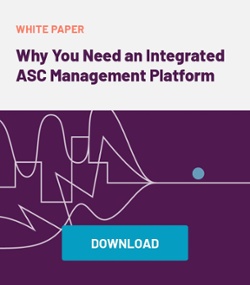
- Practice Management Systems, Patient Safety, ASC Regulations, ASC Operations, ASC Safety
- BY: Marta Shultz
- Jul 6, 2021
Ambulatory Surgery Centers have long been considered safer than hospitals by most that work at an ASC and probably by the general public. In part that is because the types of procedures performed at ASCs tend to have a lower risk of death or long-term harm. In fact, the Centers for Medicare & Medicaid Services (CMS) deem what type of procedures they will pay for in an ambulatory setting based on risk and need for extended care. Most insurers follow the CMS guidelines as well.
Patients who go to an ASC for a procedure are also typically healthier than patients who might have to use a hospital for the same procedure. Doctors perform the same surgery hundreds or thousands of times per year, which increases competence. Staff are usually dedicated to the same functions in an ASC and likely haven’t pulled a graveyard shift after having been asked to work a double to cover short staffing that day.
Which is great, until it isn’t. True, the death rate is very low for the over 9,000 US ASCs that perform millions of procedures a year. However, more than 260 deaths were reported between 2013-2018 during or immediately post procedure. If you are the patient or the patient’s family, then any infection, any adverse event, any death is one too many.
Risk Management 101
Risk Management is a very broad topic. Most in clinical settings think of adverse events, patient centered issues that are unplanned/unexpected. Sometimes they are known risks but still unplanned (ex: tooth damage during intubation)
As a facility, prevention is always the first line of Risk Management. Then there is documentation of the event, reporting events to outside agencies, root cause analysis of any severe event, review of events for trends/patterns and even defending the physician/staff/facility in case of legal action. We will cover some of these topics in future articles. For now, let’s talk more about the documentation of an event.
Event Documentation
Every regulatory body requires that key events are documented. Many states require that certain events are reported to the state, New York and Texas to name just two. CMS requires, as part of the Medicare/Medicaid certification, that facilities track adverse events. Documenting near miss events is recommended and these should be clearly identified on the form.
In 2005 Patient Safety and Quality Improvement Act of 2005 (Patient Safety Act) was passed and the Agency for Healthcare Research and Quality (AHRQ) was authorized to coordinate the development of Common Formats for reporting and analysis of patient safety data. While these formats have been geared for hospitals and nursing homes, many of the data points and definitions are appropriate for ASCs. Common Formats version 2.0 can be accessed at www.psoppc.org
Just the Facts...
There are several elements that should be tracked on any form. It must include enough detail about the event to serve as a reminder for those reviewing. It should not include opinion and conjecture. Often times forms are made to be very complicated as the form developer tries to include every adverse event that has ever happened or could happen. In the paper world, the print can be so small on this type of form that much of the form is not completed because it’s just too difficult to read and takes too long to complete. It’s more important that the who, what, where and when are captured.
Who? Should include the person or persons impacted as well as witnesses, reporter, for surgical events - names of staff in the area where the event occurred and if patient related, patient’s provider.
What (happened)? Broader categories are often more helpful in trending ASC events where typically there are not a large volume of incidents. It’s better to know if you are having more equipment issues vs. medication issues as a whole than having 100 seemingly different events. Some Event categories you might consider:
- Medication or other Substance
- Falls
- Just Wrong- Wrong site, wrong surgery, wrong person
- Equipment Failures: Device or Medical/Surgical Supply
- Anesthesia related
- Blood or Blood Product
- Healthcare-associated Infection
- Surgery, including invasive procedures
- Thromboembolism
- Other
This should also include the severity and description of injury. Severity Classifications are defined in the V2.0 version of the AHRQ Common Formats* as the following:
- Mild: Awareness of signs or symptoms, but easily tolerated and are of minor irritant type causing no loss of time from normal activities. Symptoms do not require therapy or a medical evaluation; signs and symptoms are transient.
- Moderate: Events introduce a low level of inconvenience or concern to the participant and may interfere with daily activities, but are usually improved by simple therapeutic measures; moderate experiences may cause some interference with functioning
- Severe: Events interrupt the participant’s normal daily activities and generally require prolonged care/hospitalization, causes persistent or significant disability or is life threatening
- Death
Description of the Injury should also be a short list of types of injuries with the ability to document where the injury is located on the patient. Example: Contusion, Left elbow
Many forms will have a large text area for description of event. While this can be helpful, it can also become a legal nightmare. There needs to be enough information to detail what happened. It should be factual and succinct. It is important when educating staff on form completion to reiterate this. A form with hyperbole, conjecture or inflammatory comments can cause a lot of harm in the wrong hands.
When: Date and Time of the Event and Date/Time reported to the patient provider.
Where: At Simplify ASC we recommend that this be a specific list of rooms/areas. This information can be helpful in tracking seemingly one-off events that are actually occurring due to circumstances specific to a room or area. Falls in a parking lot are a good example of this or supply deficits in a particular room can point to an opportunity for improvement.
Building a Foundation
Establishing a good reporting format for adverse events can be a solid foundation for a Risk Management program and helpful in identifying opportunities for improvement. As mentioned before, it is a broad topic and there are plenty of resources available to assist. For more information on how Simplify ASC's platform can aid you in this and other areas, please contact us.
Start your journey towards more detailed quality reporting today.


